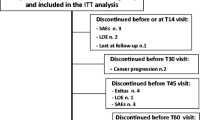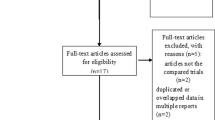Abstract
Introduction
Oxycodone is one of the most commonly used opioid analgesics in the clinical management of pain. The present retrospective analysis aimed to determine the dose of oxycodone that could achieve effective control of moderate pain when combined with a fixed dose of acetaminophen, and the time required to reach a clinically relevant reduction in intensity of pain.
Methods
Data of patients treated with a combination of oxycodone (5, 10, and 20 mg) and acetaminophen (325 mg) were evaluated for gender, current disease condition, basal pain intensity, total daily dose, days of controlled pain at the initial low dose, and pain intensity after treatment using a numeric pain rating scale.
Results
Data from a total of 491 patients were assessed; of these 93.5% of patients experienced persistent non-cancer pain and had an average baseline pain score of 5.68 ± 1.35. For the overall population, the pain score was reduced to 2.49 ± 1.71 with a mean dose of 8.68 ± 4.96 mg oxycodone after 21.60 ± 6.12 days of treatment with the combination. Almost 97% of the patients who reported relief of pain received 1.61 ± 0.67 doses of oxycodone 5 mg combined with 325 mg of acetaminophen.
Conclusion
A low-dose combination of oxycodone with acetaminophen can be effective in the management of moderate pain and may help in reducing the treatment-associated adverse reactions and drug dependence.
Funding
Sponsorship for article processing charges was provided by Molteni Farmaceutici, Florence, Italy.

Similar content being viewed by others
References
Molton IR, Terrill AL. Overview of persistent pain in older adults. Am Psychol. 2014;69(2):197–207.
Helm R, Gibson S. Pain in older people. Epidemiology of pain. Seattle: IASP; 1999. p. 103–12.
Chou R, Fanciullo GJ, Fine PG, et al. Clinical guidelines for the use of chronic opioid therapy in chronic noncancer pain. J Pain. 2009;10(2):113–30.
Caraceni A, Hanks G, Kaasa S, et al. Use of opioid analgesics in the treatment of cancer pain: evidence-based recommendations from the EAPC. Lancet Oncol. 2012;13(2):e58–68.
Schug SA, Goddard C. Recent advances in the pharmacological management of acute and chronic pain. Ann Palliat Med. 2014;3(4):263–75.
Davis MP, Varga J, Dickerson D, et al. Normal-release and controlled-release oxycodone: pharmacokinetics, pharmacodynamics, and controversy. Support Care Cancer. 2003;11(2):84–92.
World Health Organization. Cancer pain relief: with a guide to opioid availability. 2nd ed. Geneva, Switzerland: World Health Organization; 1996.
Leow KP, Smith MT, Williams B, Cramond T. Single-dose and steady-state pharmacokinetics and pharmacodynamics of oxycodone in patients with cancer. Clin Pharmacol Ther. 1992;52(5):487–95.
Lalovic B, Kharasch E, Hoffer C, et al. Pharmacokinetics and pharmacodynamics of oral oxycodone in healthy human subjects: role of circulating active metabolites. Clin Pharmacol Ther. 2006;79(5):461–79.
Andreassen TN, Klepstad P, Davies A, et al. Influences on the pharmacokinetics of oxycodone: a multicentre cross-sectional study in 439 adult cancer patients. Eur J Clin Pharmacol. 2011;67(5):493–506.
Panerai AE. Oxycodone/acetaminophen fixed-dose combination in chronic non malignant pain treatment. Trends Med. 2009;9(1):27–35.
Gatti A, Sabato E, Di Paolo AR, Mammucari M, Sabato AF. Oxycodone/paracetamol: a low-dose synergic combination useful in different types of pain. Clin Drug Investig. 2010;30(Suppl 2):3–14.
Labianca R, Sarzi-Puttini P, Zuccaro SM, et al. Adverse effects associated with non-opioid and opioid treatment in patients with chronic pain. Clin Drug Investig. 2012;32(Suppl 1):53–63.
Gatti A, Mammucari M, Sabato E, et al. Adherence and long-term effect of oxycodone/paracetamol in chronic noncancer pain: a retrospective study. Adv Ther. 2011;28(5):418–26.
U.S. Food and Drug Administration. FDA Drug Safety Communication: Prescription Acetaminophen Products to be Limited to 325 mg Per Dosage Unit; Boxed Warning Will Highlight Potential for Severe Liver Failure. 2011. http://www.fda.gov/drugs/drugsafety/ucm239821.htm. Accessed 06 Nov 2015.
U.S. Food and Drug Administration. Acetaminophen Prescription Combination Drug Products with more than 325 mg: FDA Statement—Recommendation to Discontinue Prescribing and Dispensing. 2014. http://www.fda.gov/Safety/MedWatch/SafetyInformation/SafetyAlertsforHumanMedicalProducts/ucm381650.htm. Accessed 06 Nov 2015.
Geppetti P, Benemei S. Pain treatment with opioids: achieving the minimal effective and the minimal interacting dose. Clin Drug Investig. 2009;29(Suppl 1):3–16.
Ripamonti CI, Santini D, Maranzano E, Berti M, Roila F. Management of cancer pain: ESMO clinical practice guidelines. Ann Oncol. 2012;23(Suppl 7):vii139–54.
Italian Association of Medical Oncology. [Pain therapy in oncology]. 2015. http://www.aiom.it/professionisti/documenti-scientifici/linee-guida/1,413,1,#TopList. Accessed 21 April 2016.
Gatti A, Sabato AF, Carucci A, Bertini L, Mammucari M, Occhioni R. Adequacy assessment of oxycodone/paracetamol (acetaminophen) in multimodal chronic pain: a prospective observational study. Clin Drug Investig. 2009;29(1):31–40.
Corsinovi L, Martinelli E, Fonte G, et al. Efficacy of oxycodone/acetaminophen and codeine/acetaminophen vs. conventional therapy in elderly women with persistent, moderate to severe osteoarthritis-related pain. Arch Gerontol Geriatr. 2009;49:378–82.
Raffaeli W, Pari C, Corvetta A, et al. Oxycodone/acetaminophen at low dosage: an alternative pain treatment for patients with rheumatoid arthritis. J Opioid Manag. 2010;6:40–6.
Raffa RB. Pharmacology of oral combination analgesics: rational therapy for pain. J Clin Pharm Ther. 2001;26(4):257–64.
Gammaitoni AR, Galer BS, Lacouture P, Domingos J, Schlagheck T. Effectiveness and safety of new oxycodone/acetaminophen formulations with reduced acetaminophen for the treatment of low back pain. Pain Med. 2003;4(1):21–30.
U.S. Food and Drug Administration. FDA recommends health care professionals discontinue prescribing and dispensing prescription combination drug products with more than 325 mg of acetaminophen to protect consumers. 2014. http://www.fda.gov/Drugs/DrugSafety/ucm381644.htm.Accessed 03 Feb 2014.
Corsinovi L, Martinelli E, Fonte G, et al. Efficacy of oxycodone/acetaminophen and codeine/acetaminophen vs. conventional therapy in elderly women with persistent, moderate to severe osteoarthritis-related pain. Arch Gerontol Geriatr. 2009;49(3):378–82.
Rosenblum A, Marsch LA, Joseph H, Portenoy RK. Opioids and the treatment of chronic pain: controversies, current status, and future directions. Exp Clin Psychopharmacol. 2008;16(5):405–16.
Coxib and traditional NSAID Trialists’ (CNT) Collaboration, Bhala N, Emberson J, Merhi A, et al. Vascular and upper gastrointestinal effects of non-steroidal anti-inflammatory drugs: meta-analyses of individual participant data from randomised trials. Lancet. 2013;382(9894):769–79.
Acknowledgments
No funding or sponsorship was received for this study. Sponsorship for article processing charges was provided by Molteni Farmaceutici, Florence, Italy. All named authors meet the International Committee of Medical Journal Editors (ICMJE) criteria for authorship for this manuscript, take responsibility for the integrity of the work as a whole, and have given final approval to the version to be published. The authors thank Nishad Parkar, PhD, of Springer Healthcare Communications, for English and styling of the manuscript before submission. This medical writing assistance was funded by Molteni Farmaceutici, Florence, Italy. The authors would also like to thank Ennio Sarli (Progetti Live Surgery s.r.l. Florence, Italy) for data analyses and support.
Disclosures
Silvia Natoli, Marzia Lazzari, Roberta Carpenedo, Elisa Palombo, Maria Beatrice Silvi, Massimo Mammucari, and Mario Dauri have nothing to disclose.
Compliance with Ethics Guidelines
All procedures followed were in accordance with the ethical standards of the responsible committee on human experimentation (institutional and national) and with the Helsinki Declaration of 1964, as revised in 2013. Informed consent was obtained from all patients for being included in the study.
Author information
Authors and Affiliations
Corresponding author
Additional information
Enhanced content
To view enhanced content for this article go to http://www.medengine.com/Redeem/93C4F0604D8DBCDC.
Rights and permissions
About this article
Cite this article
Natoli, S., Lazzari, M., Carpenedo, R. et al. Retrospective Evaluation of a Fixed-Dose Combination of Oxycodone and Acetaminophen to Manage Moderate Pain: The Lower the Better. Adv Ther 33, 1025–1032 (2016). https://doi.org/10.1007/s12325-016-0339-0
Received:
Published:
Issue Date:
DOI: https://doi.org/10.1007/s12325-016-0339-0




